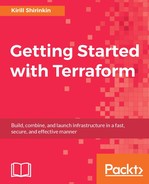Before starting to learn Terraform, you first need to learn certain concepts in the modern infrastructure. To be able to use the new tool, one needs to understand what problem it solves. In order to do it, this chapter will cover the following topics:
- Learning what Infrastructure as Code is and why it is needed
- Understanding the benefits of declarative approach for configuration management
- Explaining the missing points of configuration management tools
- Laying out requirements for high-level infrastructure automation
- Taking a quick look at main tools in order to provision infrastructure
- The short overview and history of Terraform
- What you will learn in this book
The amount of servers used by almost any project is growing rapidly mostly due to increasing adoption of cloud technologies. As a result, traditional ways of managing IT infrastructure become less and less relevant.
The manual approach fits well for the farm of a dozen, perhaps even a couple of dozens of servers. But when we're talking about hundreds of them, doing anything by hand is definitely not going to play out well.
It's not only about servers, of course. Every cloud provider gives extra services on top, be it a virtual networking service, an object storage, or a monitoring solution, which you don't need to maintain yourself. These services function like a Software as a Service (SaaS). And actually, we should treat various SaaS products as part of our infrastructure as well. If you use NewRelic for monitoring purposes, then it is your infrastructure too, with the difference that you don't need to manage servers for it yourself. But how you use it and whether you use it correctly is up to you.
No surprises, companies of any size, from small start-ups to huge enterprises, are adopting new techniques and tools to manage and automate their infrastructures. These techniques got a new name eventually: Infrastructure as Code (IaC).
Dated something around 2009, the Infrastructure as Code term is all about approaching your IT-infrastructure tasks the same way you develop software. This includes the things similar to the following:
- Heavy use of source control to store all infrastructure-related code
- Collaboration on this code in the same fashion as applications are developed
- Using Unit and Integration testing and even applying Test-driven development to infrastructure code
- Introducing Continuous Integration and Continuous Delivery to test and release infrastructure code
Infrastructure as Code is a foundation for DevOps culture because once both operations and developers approach their work in the same way and by following principles laid out preceding, they already have some common ground.
Not saying that if your infrastructure is treated like code, then the border between development and operations becomes so blurry that the whole existence of this separation can become eventually quite questionable.
Of course, the introduction of Infrastructure as Code requires a new kind of tools.
